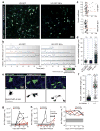HIV-infected T cells are migratory vehicles for viral dissemination
- PMID: 22854780
- PMCID: PMC3470742
- DOI: 10.1038/nature11398
HIV-infected T cells are migratory vehicles for viral dissemination
Abstract
After host entry through mucosal surfaces, human immunodeficiency virus-1 (HIV-1) disseminates to lymphoid tissues to establish a generalized infection of the immune system. The mechanisms by which this virus spreads among permissive target cells locally during the early stages of transmission and systemically during subsequent dissemination are not known. In vitro studies suggest that the formation of virological synapses during stable contacts between infected and uninfected T cells greatly increases the efficiency of viral transfer. It is unclear, however, whether T-cell contacts are sufficiently stable in vivo to allow for functional synapse formation under the conditions of perpetual cell motility in epithelial and lymphoid tissues. Here, using multiphoton intravital microscopy, we examine the dynamic behaviour of HIV-infected T cells in the lymph nodes of humanized mice. We find that most productively infected T cells migrate robustly, resulting in their even distribution throughout the lymph node cortex. A subset of infected cells formed multinucleated syncytia through HIV envelope-dependent cell fusion. Both uncoordinated motility of syncytia and adhesion to CD4(+) lymph node cells led to the formation of long membrane tethers, increasing cell lengths to up to ten times that of migrating uninfected T cells. Blocking the egress of migratory T cells from the lymph nodes into efferent lymph vessels, and thus interrupting T-cell recirculation, limited HIV dissemination and strongly reduced plasma viraemia. Thus, we have found that HIV-infected T cells are motile, form syncytia and establish tethering interactions that may facilitate cell-to-cell transmission through virological synapses. Migration of T cells in lymph nodes therefore spreads infection locally, whereas their recirculation through tissues is important for efficient systemic viral spread, suggesting new molecular targets to antagonize HIV infection.
Figures




Comment in
-
Viral pathogenesis: HIV hitchhikes on migratory T cells.Nat Rev Microbiol. 2012 Oct;10(10):673. doi: 10.1038/nrmicro2877. Epub 2012 Aug 20. Nat Rev Microbiol. 2012. PMID: 22903165 No abstract available.
-
Viral pathogenesis: HIV hitchhikes on migratory T cells.Nat Rev Immunol. 2012 Sep;12(9):620-1. doi: 10.1038/nri3287. Nat Rev Immunol. 2012. PMID: 22918462 No abstract available.
References
-
- Haase AT. Early events in sexual transmission of HIV and SIV and opportunities for interventions. Annu Rev Med. 2011;62:127–39. - PubMed
-
- Sattentau Q. Avoiding the void: cell-to-cell spread of human viruses. Nat Rev Microbiol. 2008;6:815–26. - PubMed
-
- Gebhardt T, et al. Different patterns of peripheral migration by memory CD4+ and CD8+ T cells. Nature. 2011;477:216–9. - PubMed
-
- Mempel TR, Henrickson SE, von Andrian UH. T-cell priming by dendritic cells in lymph nodes occurs in three distinct phases. Nature. 2004;427:154–9. - PubMed
-
- Melkus MW, et al. Humanized mice mount specific adaptive and innate immune responses to EBV and TSST-1. Nat Med. 2006;12:1316–22. - PubMed
Publication types
MeSH terms
Grants and funding
LinkOut - more resources
Full Text Sources
Other Literature Sources
Medical
Research Materials

